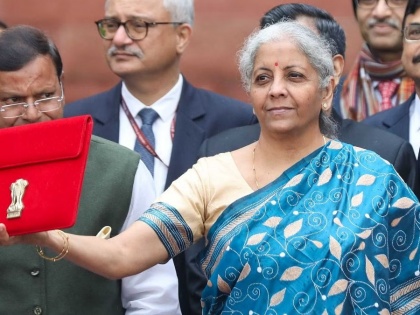Budget 2024–2025 Summary: Key Takeaways From Interim Union Budget
By Lokmat English Desk | Published: February 1, 2024 01:07 PM2024-02-01T13:07:25+5:302024-02-01T13:07:30+5:30
Finance Minister Nirmala Sitharaman made history on Thursday as she presented her sixth consecutive budget, joining the ranks of ...

Budget 2024–2025 Summary: Key Takeaways From Interim Union Budget
Finance Minister Nirmala Sitharaman made history on Thursday as she presented her sixth consecutive budget, joining the ranks of former Prime Minister Morarji Desai. The milestone comes just ahead of crucial Parliamentary elections. Here's a summary of the key highlights from her latest budget announcement.
Capital Expenditure Increased:
The Finance and Corporate Affairs Minister, Smt Nirmala Sitharaman, announced an 11.1 per cent increase in capital expenditure outlay for the next fiscal year, reaching Rs 11,11,111 crore, equivalent to 3.4 per cent of the GDP.
Robust Economic Growth:
India's Real GDP is projected to grow at 7.3 per cent in FY 2023-24, reflecting a resilient economy amidst global challenges. The IMF and other international agencies have revised growth projections upwards, indicating confidence in India's economic prowess.
Revenue Collections and Fiscal Deficit:
GST collections stood at ₹1.65 lakh crore in December 2023, reflecting strong economic activity. Total receipts, excluding borrowings, for 2024-25 are estimated at Rs 30.80 lakh crore, with tax receipts projected at Rs 26.02 lakh crore. The fiscal deficit for 2024-25 is estimated to be 5.1 per cent of GDP, adhering to the path of fiscal consolidation.
Key Initiatives and Investments:
- The scheme of fifty-year interest-free loans for capital expenditure to states will continue, with a total outlay of Rs 1.3 lakh crore.
- A provision of Rs 75,000 crore as fifty-year interest-free loans is proposed to support milestone-linked reforms.
- To encourage sustained foreign investment, bilateral investment treaties with foreign partners are being negotiated.
- Focus on marginalized sections: The government prioritizes the needs of the poor, women, youth, and farmers, aiming for inclusive development.
Infrastructure and Development:
- The government aims to make India a 'Viksit Bharat' by 2047, focusing on improving people's capabilities and empowerment.
- Investments in railway corridor programs, aviation sector expansion, and housing schemes like PM Awas Yojana.
- Establishment of a high-powered committee to address challenges arising from population growth and demographic changes.
- Taxation and Direct Tax Collections:
No changes in tax rates proposed; existing rates retained for direct and indirect taxes.
- Tax benefits extended for Start-Ups and investments made by sovereign wealth or pension funds.
- Withdrawal of outstanding direct tax demands up to Rs. 25,000 for certain periods, benefiting about a crore taxpayers.
- Direct tax collections have more than trebled over the last decade, with improvements in taxpayer services and simplified filing processes.
Indirect Taxes and GST:
- GST has reduced compliance burdens, leading to a positive transition for trade and industry.
- GST tax base has doubled, with average monthly gross GST collections reaching Rs. 1.66 lakh crore.
- Measures taken to facilitate international trade, resulting in reduced import release times across various ports.
White Paper on Indian Economy:
The government plans to release a white paper detailing the progress made since 2014 and lessons learned from past economic mismanagement, emphasizing the nation's strong belief in prioritizing national interests.